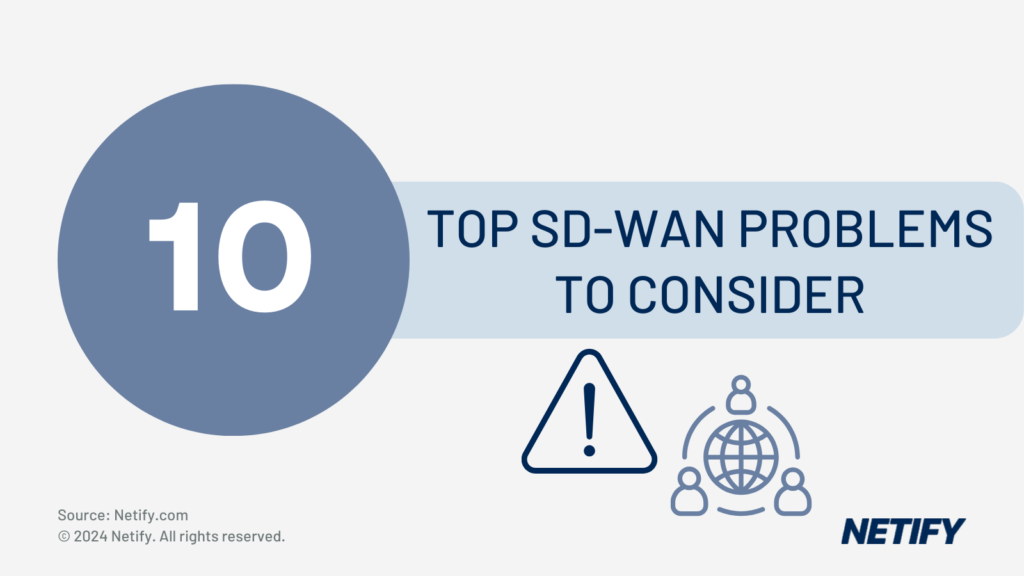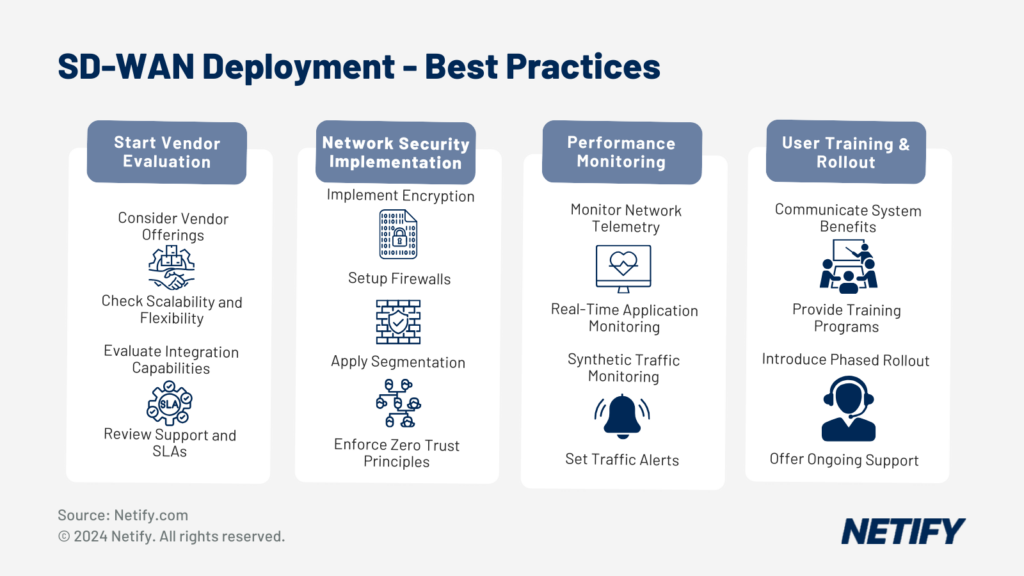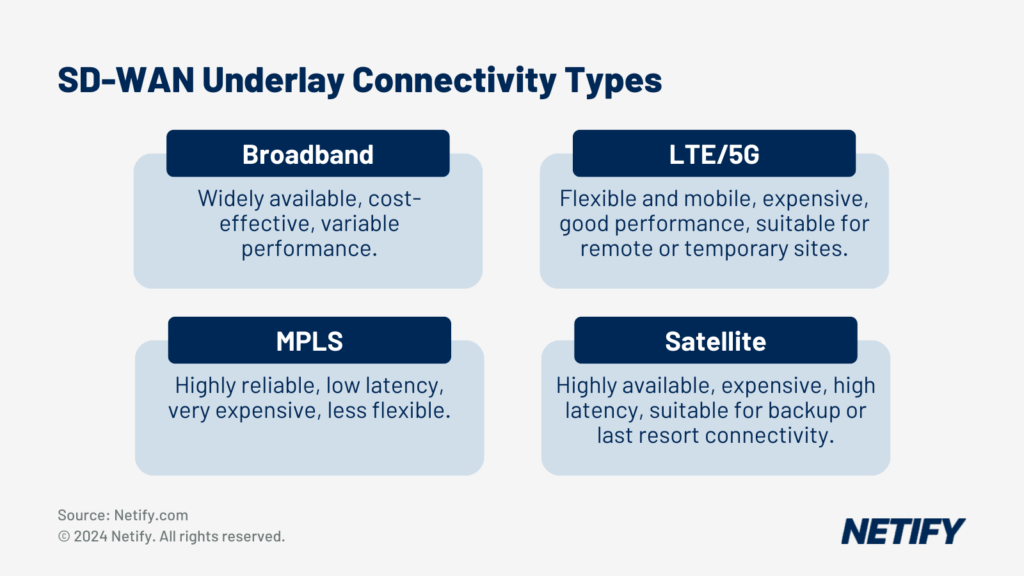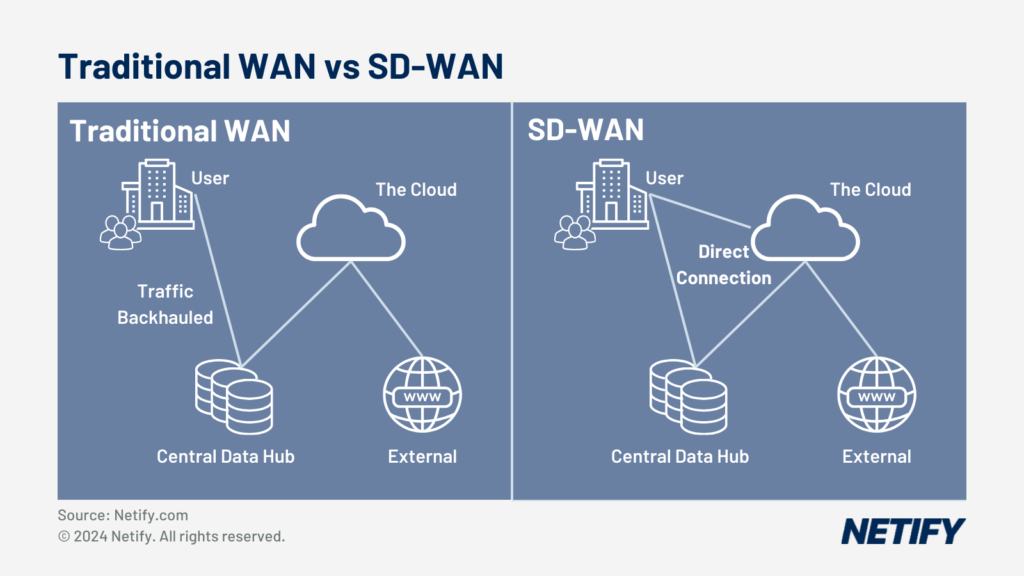The top 10 problems that arise with SD-WAN to consider are:
|

Businesses are increasingly opting to utilise Software Defined Wide Area Network (SD-WAN) solutions to improve their network performance, security and scalability. Whilst SD-WAN offers many solutions to the issues posed by traditional WAN architectures, it also comes with its own challenges.
This article explores the top ten issues that can arise when implementing and managing SD-WAN, which often leave businesses feeling that they haven’t got the most out of their new networking solution.
From the initial setup and integration with existing infrastructure to ongoing management and security concerns, it’s essential to understand these potential problems and how you, an IT decision maker, can proactively mitigate them.
Configuration Complexity
For many businesses, the first potential issue that businesses can come across with SD-WAN is the setup process. Integrating multiple network paths, edge devices across various branch locations, implementing security services and routing policies make setting up SD-WAN potentially complex. For novice network administrators, human error can be a major issue, as misconfigurations are easy and can lead to degraded performance, security vulnerabilities or a lack of flexibility and scalability for larger networks.
The most common of these misconfigurations is choosing an SD-WAN vendor that doesn’t meet your business needs, such as inadequate security features, an inability to prioritise or support critical applications and failing to integrate their SD-WAN into the existing network and security architecture. These mistakes often stem from a lack of planning, skills gaps, and unrealistic expectations.
To simplify the configuration process and prevent misconfigurations, many SD-WAN solutions have implemented provisioning templates for automated setup. Provisioning templates can be vendor-created or custom-made by network administrators and they often define the basic network connections, policies for security and application routing. Through automation, this minimises the need for manual work, reducing workload complexity and preventing human error from causing misconfigurations.
To compliment the automated configuration process, network administration teams should define granular security and application routing policies prior to integrating the solution, train administrator staff on SD-WAN and consider a Secure Access Service Edge (SASE) approach to ensure that the network is built from the ground up, based on principles aligned with company needs and future requirements. This can be better realised by starting the integration phase with a limited pilot deployment, which can be used to validate the design before expanding across the entire network, whilst proactive monitoring and troubleshooting using analytics can help to enhance network configuration once further along the deployment timeline.
Deployment Challenges

Whilst provisioning of SD-WAN can be automated, deployment can still experience compatibility issues with existing infrastructure. Legacy systems and hardware may not fully support SD-WAN features, requiring additional configuration or upgrades. Integrating SD-WAN with existing network components can lead to configuration problems, with this incompatibility often being emphasised in environments that leverage products from multiple vendors.
These compatibility issues can be mitigated via prior assessments into the current network infrastructure, outlining and identifying potential incompatibilities and working closely with SD-WAN vendors for proper integration and configuration with existing systems. Without these considerations, changing system implementations to meet SD-WAN may result in large costs and delays in deployment time, therefore making prior assessment essential to the deployment process.
Management Overhead
One of the core features of SD-WAN is the centralised management pane, which facilitates automation and remote configuration of all edges. Despite this feature, SD-WAN still requires continuous management, such as monitoring network performance and security, troubleshooting issues, applying updated security patches and ensuring SD-WAN remains compatible with changes to other networked systems and services.
To establish an efficient approach to managing SD-WAN solutions, businesses should adapt to balance automated and manual control, with low-risk tasks such as backups being automated, and high-risk tasks being manually controlled by a network administration team.
To reduce the volume of management overhead, network administrators should look to leverage the inbuilt-tools provided by their SD-WAN solution. Many solutions have now integrated Artificial Intelligence (AI) to manage operations, whilst also providing standardised configuration policies, offer role-based access control and a unified visibility and control pane, simplifying the complexity of management. The introduction of AI and Machine Learning (ML) are being increasingly used to enhance SD-WAN capabilities, with AI evaluating network real-time telemetry data, analysing patterns to find anomalies and detecting performance issues or threats before they have even affected the network. This enables the SD-WAN orchestrator to provide proactive issue response, optimising network efficiency and user experience (UX).
Underlay Network Latency

Network Latency, the round-trip time delay for data transmission between a source and destination within a network, is one of the key metrics that significantly impacts overall network performance and user experience. High latency leads to slow page loads, poor application responsiveness, and decreased user satisfaction. It creates bottlenecks that reduce effective bandwidth and in industries relying on real-time data, such as within manufacturer’s production lines, low latency is critical.
There are many causes of network latency, including:
- Physical distance between networked devices
- Processing delays at network appliances (routers/switches)
- Transmission medium
- Bandwidth constraints
- High traffic volumes
As SD-WAN acts as a network overlay, it is imperative that network administrators and IT decision makers first consider their network underlay prior to implementing SD-WAN. By adopting dedicated transmission lines, such as MPLS or finding an SD-WAN vendor that has their own backbone, can be crucial for minimising latency from transmission mediums, physical distance or bandwidth limitations. Common supplementary techniques to reduce latency include using content delivery networks (CDNs) for file transfer, better optimised protocols for communications, traffic shaping for managing bandwidth and edge computing for reducing the volume of data transferred across the network.
Deploying SD-WAN with an optimised, low-latency underlay reduces the complexity of processes that the SD-WAN solution will need to apply to maintain application performance. It is also recommended that network administrators conduct regular testing and create performance baselines in order to better detect performance drops or SLAs not being met, allowing for proactive issue identification and rapid resolution of latency.
Jitter Problems
Similar to latency, Jitter refers to the variation in packet arrival times across a network, with high jitter negatively impacting the performance of real-time applications like Voice over Internet-Protocol (VoIP), video conferencing and virtual desktops.
SD-WAN solutions reduce jitter by dynamically selecting the best-performing paths for each application based on real-time network telemetry. The most common causes of jitter are:
- Network congestion
- Packet loss and retransmissions
- Routing instability
- Mixing real-time and non-real-time traffic without proper Quality of Service (QoS)
- High CPU utilisation on SD-WAN appliances.
Like with latency, ensuring the underlying network infrastructure is capable of handling communications is crucial for minimising jitter. To assist with reducing jitter, SD-WAN implementations use Quality of Service mechanisms to prioritise real-time traffic, forward error correction (FEC) to recover from packet loss and jitter buffering to smooth out packet arrival times.
Through SD-WAN’s built in traffic steering and assessment of network telemetry, SD-WAN can route communications to avoid poorly performing network links in real-time, reducing the likelihood of jitter.
Security Concerns
Unlike with traditional WAN networks, SD-WAN prevents the need for traffic to be routed via a centralised hub before accessing cloud resources, enabling localised breakout points, which without proper security planning, creates a vulnerability for the network by exposing new attack surfaces.

Further to this, given SD-WAN offers a remote pane for orchestration, this presents a single point of failure that requires security processes to ensure it does not become compromised. If breached, this allows malicious actors to gain access and control to the network across all branches, posing a serious threat to businesses.
To mitigate these risks, organisations should implement a zero-trust security model with strict access controls and segmentation. Businesses looking to implement Zero Trust Network Access (ZTNA) should consider using a SASE framework platform, which unifies security policies across all edges and helps to enforce the Zero Trust model.
Businesses should also utilise strong authentication methods, such as multi-factor authentication where available and role-based access control for SD-WAN management interfaces, minimising both the risk of breaches initially occurring and the scope of the management pane that a given breach can access. To supplement this, network administrators should regularly update their SD-WAN software and security signatures and conduct thorough security testing and audits to ensure that systems, processes and staff security habits do not become outdated or inadequate.
Scalability Issues
When initially selecting a vendor or implementing an SD-WAN solution, it is often easy for IT decision makers and network administrators to forget about scalability considerations. As organisations expand their networks to support more users, devices, and applications across distributed locations, they require their network to continuously adapt and grow to meet demand.
There are many challenges associated with SD-WAN scalability, such as maintaining consistent policies and configurations across all devices and sites, ensuring adequate bandwidth and performance as traffic volumes increase, securely onboarding and managing a growing number of remote endpoints and IoT devices, integrating SD-WAN with multi-cloud environments, and troubleshooting issues across a large-scale deployment.
To address these issues, SD-WAN vendors offer features including Zero Touch Provisioning (ZTP) for automated deployment and configuration of new devices, integrated SASE for scalable cloud-native security and performance monitoring analytics to help identify issues with increasing the scale of the network.
Interoperability with Legacy Systems
Integrating SD-WAN with legacy network components can be problematic due to differences in capabilities and protocols. Legacy routers, switches, and firewalls may not support SD-WAN features, which can create bottlenecks and downtime. The inconsistencies between legacy and SD-WAN components in routing protocols, QoS, and security policies can arise, complicating management and troubleshooting.
To achieve seamless interoperability, organisations should assess their current network environment to identify potential gaps, choose SD-WAN solutions with broad compatibility, use network overlays and protocol translation to bridge legacy and SD-WAN domains, seek professional management services and support from SD-WAN vendors and partners and take a phased approach to gradually integrate SD-WAN while maintaining legacy connectivity.
Quality of Service (QoS) Management
One of the interoperability issues between legacy and SD-WAN components included quality of service management. Ensuring consistent QoS across an SD-WAN deployment involves defining policies that can prioritise critical applications and traffic types, configuring QoS settings on SD-WAN devices to enforce policies across all WAN links and paths, leveraging dynamic path selection to route traffic.
Monitoring the performance of Quality-of-Service configurations is critical to ensure policies are correctly enforced and application SLAs are met. Key tools and techniques include using the SD-WAN solution’s built in monitoring and reporting capabilities to track QoS metrics like latency, jitter, and packet loss across multiple traffic classes and analysing historical QoS performance data to identify trends and anomalies in current data. To automate this process, network administrators can also setup alerts for QoS violations, which proactively detect and resolve issues.
Often the reason for QoS to become defunct is due to misconfigurations, blackouts/brownouts and issues with the underlay network, such as bandwidth restrictions on communication links.
Cost Management
For many businesses, cost savings are one of the most important factors for choosing SD-WAN over traditional WAN. While SD-WAN can provide significant cost savings, unexpected costs can arise during deployment and maintenance.
These may include upgrades to underlay networks to support increased traffic volumes, licensing fees for additional features and investments in network resiliency and redundancy.
By thoroughly assessing business requirements and selecting the most appropriate SD-WAN vendor, this issue can be minimised as it mitigates excess expenses. A cost-benefit analysis shows that SD-WAN can provide a strong return on investment (ROI) through a reduction in underlay costs (less MPLS reliance), lowering branch security expenses, minimising downtime, improving application performance, simplifying WAN management and enabling faster deployment of new sites and applications. Integrating SD-WAN deployment into a holistic SASE architecture can also provide better ROI by combining SD-WAN, security, remote access, and cloud optimisation.
Conclusion
Although the implementation of SD-WAN can bring about various challenges, understanding the causes of these issues is a key step for proactively mitigating against them. By placing an emphasis on planning an SD-WAN architecture by evaluating your business’ networking requirements, vendor offerings, legacy system interoperability and phased integration, you can ensure that your business network can leverage all of the benefits of SD-WAN, whilst also having a solid strategy in-place ready for any challenges faced.


